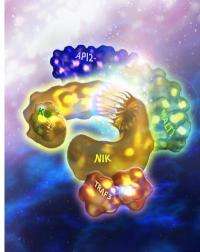Study reveals how fusion protein triggers cancer

What happens when two proteins join together? In this case, they become like a power couple, where the whole is greater than the sum of the parts.
API2 and MALT1 are two proteins that become fused together in a subset of lymphomas. The API2 part of the fusion connects with an enzyme called NIK. When it does, MALT1 comes in for the kill, splitting NIK in two, a process called cleavage.
The result? NIK is stronger than ever. It sheds its "conscience" by removing a regulatory region of the enzyme that forces NIK to behave and self-destruct. Consequently, NIK acts like a renegade protein, making cancer cells that grow, spread and resist traditional treatments.
This is the picture researchers at the University of Michigan Comprehensive Cancer Center uncovered in a study publishing in the Jan. 28 issue of Science. Led by a husband and wife team, Linda McAllister-Lucas, M.D., Ph.D., and Peter C. Lucas, M.D., Ph.D., U-M researchers coordinated an international effort that included contributions from laboratories in Great Britain and Belgium.
The API2-MALT1 fusion protein appears 30 percent to 40 percent of the time in a type of B-cell lymphoma called mucosa-associated lymphoid tissue, or MALT, lymphoma. It's never seen in any other cells.
"NIK is a critical hub that's been implicated in other B-cell cancers. Cleavage of NIK by this fusion oncoprotein suggests a new way of activating NIK, and further supports that NIK represents a potential target for developing new therapies," says McAllister-Lucas, associate professor of pediatric hematology/oncology at the U-M Medical School.
The protein fusion itself is also a potential treatment target. Neither API2 nor MALT1 alone can cause a ripple effect on NIK. It happens only when the two fuse together, with API2 providing the access for MALT1 to cause the split. Without the fusion, NIK cleavage does not happen.
"A particularly exciting feature to this discovery is that the critical cancer-causing event involves a kinase -- NIK -- and a protease -- API2-MALT1. Both kinases and proteases are considered druggable, meaning they are potential targets for developing drugs that block their activity," says Lucas, assistant professor of pathology at the U-M Medical School.
MALT lymphomas that carry the API2-MALT1 fusion protein tend to be more aggressive and more resistant to treatment. The result is larger tumors and increased spread throughout the body.
The researchers found that once NIK becomes stable, it triggers a series of downstream reactions that make cells more likely to metastasize and more resistant to current treatments.
These effects were reversed when researchers turned off NIK, suggesting that either blocking NIK or preventing NIK from becoming stable by blocking the protein fusion, could halt the growth and spread of MALT lymphoma tumors.
While NIK inhibitors are being investigated, these therapies are not currently available.
More information: Reference: Science, Vol. 331, No. 6016, Jan. 28, 2010















